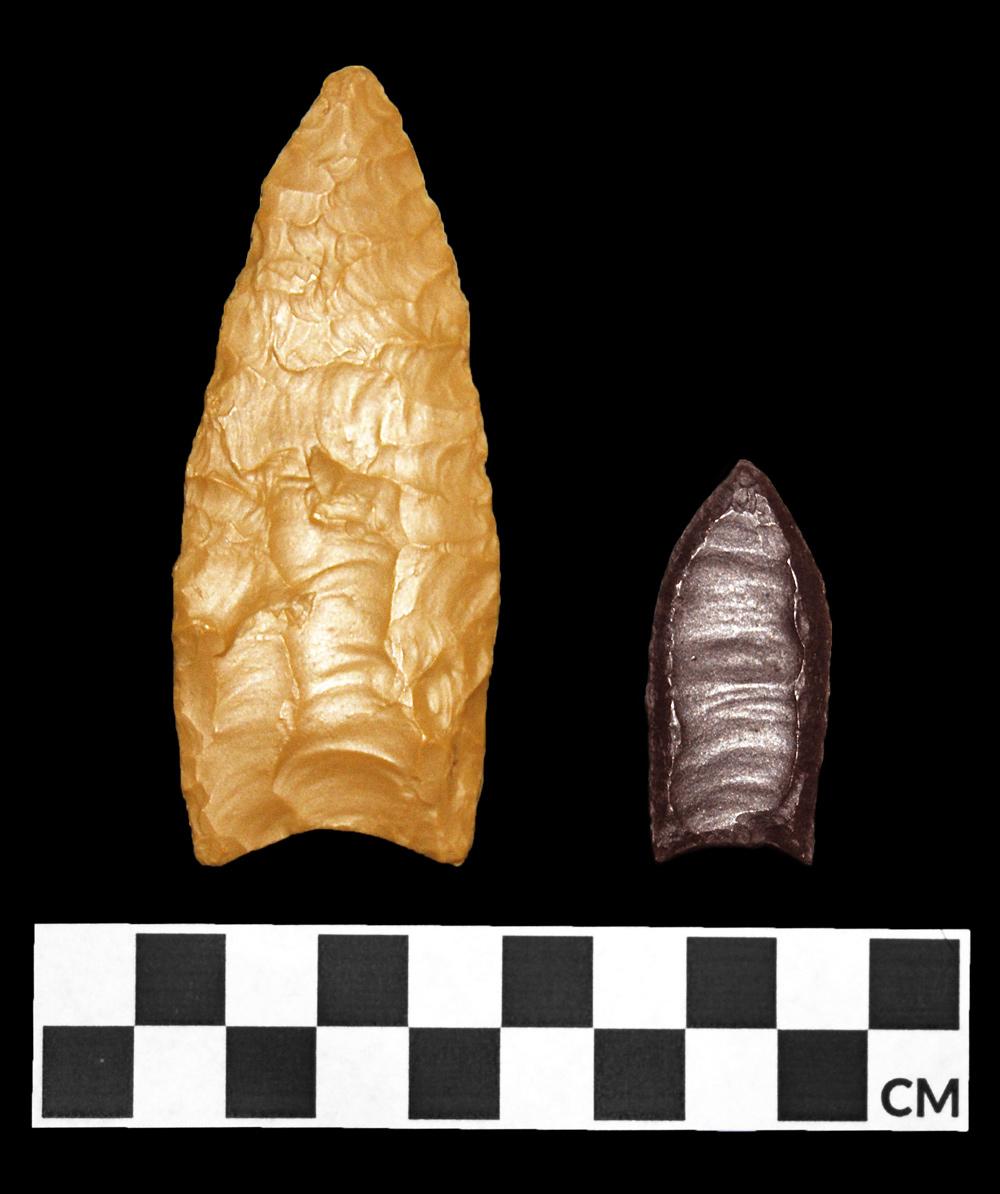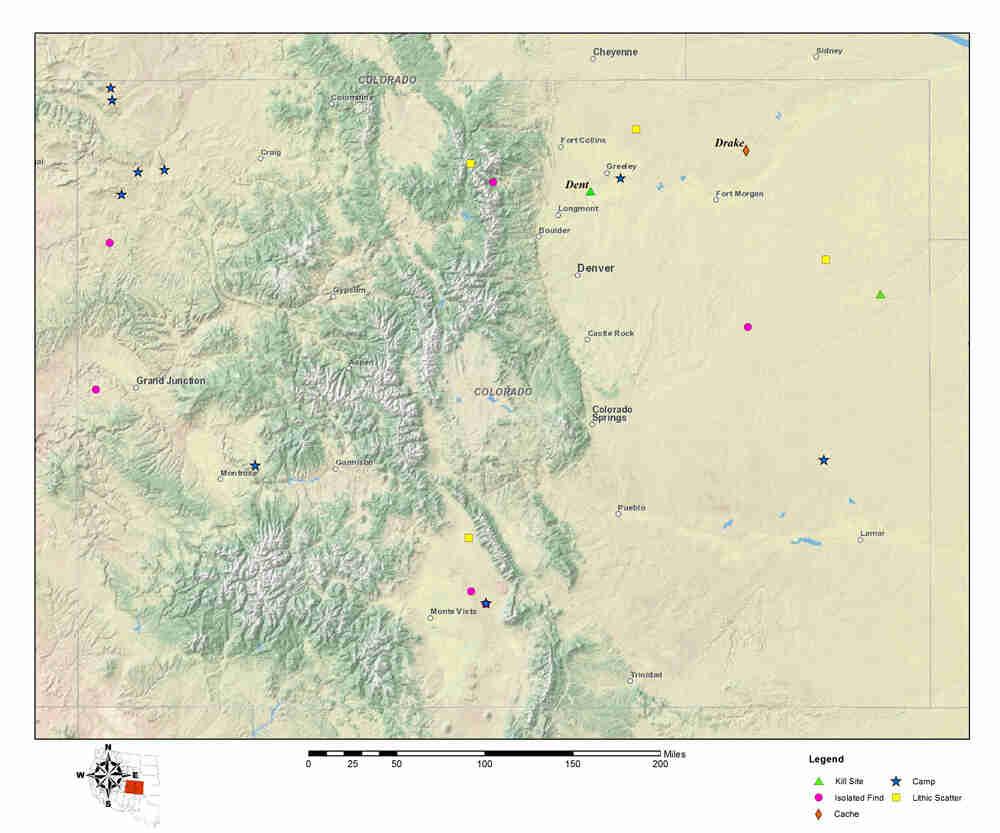Clovis
Full Article
The term Clovis refers to the earliest widespread archaeological culture to have occupied North and Central America, ca. 13,250–12,800 years ago. Since the discovery of the first Clovis artifacts in the 1930s, debate has raged over such fundamental issues as whether people who left behind Clovis materials were, in fact, the first Americans; where in the Old World Clovis ancestors originated; and whether Clovis people disproportionately killed megafauna (such as mammoths and mastodons) and avoided smaller game. From the time the term Clovis emerged to describe first Americans, Colorado’s Clovis record has played a central role in these discussions.
Background
In 1932 Regis College geology professor Father Conrad Bilgery began excavating the Dent site located just south of Greeley, recovering numerous mammoth bones and a large fluted projectile point. The following year, Colorado Museum of Natural History (today’s Denver Museum of Nature & Science) paleontology curator Jesse Figgins agreed to continue Bilgery’s work. About five years before, Figgins had overseen paradigm-shifting field research at the ancient Folsom site in northeastern New Mexico, where he discovered small, thin, fluted projectile points amidst the bones of now extinct giant bison. This work resolved a debate that had flummoxed archaeologists and the public since the mid-1800s: whether humans had lived in the Americas during the Ice Age. They clearly had, and they hunted mammals.
The Dent spearpoints reminded Figgins of Folsom projectiles writ large. He therefore referred to them as “Folsomoid” and surmised that they were simply hefty Folsom points, engineered to better penetrate thick-skinned mammoths. This interpretation changed some years later, however, after excavations at the Blackwater Draw site in east-central New Mexico exposed mammoth bones and Dent-like spearpoints below Ice Age bison bones and Folsom points. This indicated that the more robust fluted points were older than finely flaked Folsom and should be distinguished as such with distinct terminology. Because Blackwater Draw is located near the town of Clovis, New Mexico, an archaeological culture by that name—long thought to be North America’s oldest—was born.
Had Figgins recovered evidence for the greater antiquity of the large spearpoints observed at Dent, he would doubtless have named the new artifact type accordingly, and what have been known for eight decades as Clovis points would have been named for their Colorado site instead. But Clovis it was, and the debates raged on. As of this writing, most archaeologists agree that humans occupied at least parts of the Americas no less than a thousand years or so before Clovis time; Clovis ancestors occupied northeast Asia prior to immigrating to the New World; Clovis technology developed in the New World (rather than having been transported from the Old World); and Clovis people ate more than just mammoths.
Clovis Tool Kit
Although the distinctive Clovis projectile point is the most commonly recovered and best-known component of the Clovis tool kit, Clovis hunter-gatherers manufactured a wide variety of implements. These include other chipped stone artifacts, such as massive bifaces and other more specialized stone tools (e.g., scrapers, blades and blade cores, perforators, and gravers). Clovis sites have also yielded occasional bone and ivory cylindrical rods—often interpreted as the parts of composite spear-throwing devices, or atlatls, to which Clovis hunters affixed Clovis points—and in one case, an ivory shaft straightener.
Although it is virtually impossible not to appreciate the functionality and sheer beauty of the Clovis tools, it is crucial to keep in mind that after 13,000 years of exposure to the ravages of geologic and geochemical processes, the vast majority of objects they made have disintegrated. All known hunter-gatherers manufacture a wide array of perishable items (e.g., clothing, blankets, and baskets), but the more time passes, the less likely such materials will survive.
The disproportionate preservation of material culture has also prompted many archaeologists to interpret Clovis people as specialized big-game hunters. Today we find almost exclusively stone, bone, and ivory hunting tools dating to Clovis time; therefore, it follows that Clovis people must have emphasized hunting at the expense of other pursuits. That is not necessarily or even likely true, although this perspective persists in some archaeological literature and many museum exhibits.
Clovis Sites
Clovis-era sites include kill sites, camps, caches, a human burial, and many isolated occurrences of Clovis projectile points. The sites occur across North America and as far south as parts of Central America, although it remains unclear whether the thousands of isolated projectile points recovered all date to precisely the same time frame; those found in the eastern United States may be a little younger than those found west of the Mississippi River. Archaeologists also debate where Clovis projectile point technology arose and whether the technology spread from north to south, east to west, or along some other trajectory.
Unequivocal Clovis kill sites occur principally in the western United States, though a few occur elsewhere. Archaeologists identify Clovis kills by an indisputable association between Clovis projectile points and the bones of now extinct megafauna, principally mammoths and mastodons. Blackwater Draw and the Dent site are examples of only fourteen or so widely accepted Clovis kill localities in North America. Campsites are even rarer than kill sites and are identified by a wider array of artifact types and more diverse subsistence remains than single-species kills.
Like kill sites, caches occur more frequently in western North America than elsewhere. They consist of intentionally buried collections of Clovis bifaces, projectile points, blades, flakes, and other artifacts. Roughly two dozen caches have been documented in the United States—four of them in Colorado, including the well-known Drake Cache. Drake included thirteen complete Clovis projectile points made of exquisite stone from the Alibates chert quarries in the Texas Panhandle. Archaeologists consider the Anzick site in Montana to be a cache as well because it yielded eighty-six Clovis artifacts. However, that cache, unlike the others, accompanied the burial of a one- to two-year-old child with a genome similar to that of ancient Siberians and fifty-two contemporary Native American populations.
Clovis in Colorado
Colorado is physically and historically at the heart of Clovis archaeology. The Dent mammoth kill was the first professionally excavated Clovis site, which is located at roughly the geographic center of all widely known North American Clovis kills, camps, and caches. As noted, four of the twenty-three published Clovis caches on the continent—17 percent—are located within Colorado’s borders. Although the density of isolated occurrences of Clovis points and Clovis points accompanied by scatters of chipped stone debitage (lithic scatters, or when artifact diversity is high, open camps) is lower in Colorado than in some regions, the state’s site database shows that nearly two dozen such localities have been documented to date.





















